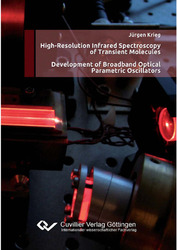| Areas | |
|---|---|
| Serie de libros (96) |
1378
|
| Nachhaltigkeit |
3
|
| Gesundheitswesen |
1
|
| Letra |
2365
|
| Ciencias Naturales |
5406
|
| Matemática | 229 |
| Informática | 319 |
| Física | 980 |
| Química | 1363 |
| Geociencias | 131 |
| Medicina humana | 243 |
| Estomatología | 10 |
| Veterinaria | 108 |
| Farmacia | 147 |
| Biología | 835 |
| Bioquímica, biología molecular, tecnología genética | 121 |
| Biofísica | 25 |
| Nutrición | 45 |
| Agricultura | 1004 |
| Silvicultura | 201 |
| Horticultura | 20 |
| Ecología y conservación de la tierra | 148 |
| Ciencias Ingeniería |
1793
|
| General |
98
|
|
Leitlinien Unfallchirurgie
5. Auflage bestellen |
|
Erweiterte Suche
High-Resolution Infrared Spectroscopy of Transient Molecules Development of Broadband Optical Parametric Oscillators (Tienda española)
Jürgen Krieg (Autor)Previo
Indice, Datei (70 KB)
Lectura de prueba, Datei (220 KB)
The infrared spectral region between wavelengths of 2 and 6 µm is of great importance in molecular physics. Molecules with an X-H bond (X being carbon, nitrogen or oxygen) exhibit strong vibrational transitions there, but also linear carbon clusters Cn (n=2,3,…). Many combination bands and overtones of low-energy vibrational modes also occur in this spectral range. Analyses of these spectral features allow – if highly resolved – for example the prediction of pure rotational transitions in the sub-mm wavelength regime, or help understanding the internal dynamics of the molecule.
To provide radiation sources with extremely large frequency coverage, two optical parametric oscillator (OPO) systems in the wavelength regions from 2.5 to 4.1 µm and from 4.7 to 5.4 µm have been set up and characterized in this thesis. The OPO system around 5 µm wavelength is the only one in this spectral region used in high-resolution spectroscopy up to now. Both of the OPO systems have been shown to be ideal tools for spectroscopic studies delivering highly accurate transition frequencies of transient molecules, using the following example cases:
The rovibrational spectrum of the fundamental cation CH2D+ around 3.2 µm wavelength has been measured with unprecedented spectral resolution and frequency accuracy. The combination of the OPO as radiation source with a cold ion trap to produce and store the ions has been proven to have a high predictive power for pure rotational transition frequencies of CH2D+. Located at around 100 to 200 GHz, these are of great importance in astrophysics.
The V3 fundamental vibration of Si2C3 around 5.1 µm wavelength has been measured using the OPO and a newly built jet spectrometer for the production of transient molecules. Molecular parameters have been determined with high precision. An associated hot band originating from the V7 vibrational bending mode has been resolved and analyzed for the first time.
The pure carbon clusters C3 and C7 have also been examined. For the first time, a combination band of C3 and an associated hot band were detected around 3.0 µm wavelength in the gas phase. Their analyses yield valuable information about the potential energy surface of C3. Analysis of the V5 mode of C7 delivered further proof of its rigidity, which was put into question by earlier works. Last but not least, a previously unknown associated hot band of C7 has been detected and analyzed.
| ISBN-10 (Impresion) | 3954040123 |
| ISBN-13 (Impresion) | 9783954040124 |
| ISBN-13 (E-Book) | 9783736940123 |
| Formato | A5 |
| Idioma | Inglés |
| Numero de paginas | 162 |
| Laminacion de la cubierta | mate |
| Edicion | 1 Aufl. |
| Volumen | 0 |
| Lugar de publicacion | Göttingen |
| Lugar de la disertacion | Köln |
| Fecha de publicacion | 13.02.2012 |
| Clasificacion simple | Tesis doctoral |
| Area |
Física
|








